
Towanda is a city in Butler County, Kansas, United States. As of the 2020 census, the population of the city was 1,447.
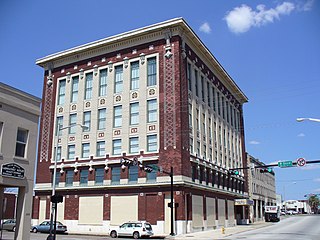
The Masonic Temple is a historic Masonic temple in Jacksonville, Florida. It is located at 410 Broad Street. Constructed by the Grand Lodge between 1901 and 1912, it was added to the U.S. National Register of Historic Places on September 22, 1980.

The Historic Triune Masonic Temple is a meetinghouse of Freemasonry in Saint Paul, Minnesota, United States, built in 1910 in the Neo-Classical Revival style, designed by Henry C. Struchen (1871–1947). The structure was built for Triune Lodge No. 190, AF & AM. It is one of the earliest and best preserved buildings erected exclusively for the use of a single Masonic Lodge. Henry Struchen, although not an architect, was a contractor and designer. He was a member of Triune Lodge and a prominent builder in the city.

The Springfield Schoolhouse, in Springfield, Colorado, is an 1889 rural schoolhouse built with sandstone quarried east of town. It is 53 by 33 feet in plan. It served as a school until 1920 when it became a Masonic Lodge. It has been known as Springfield Masonic Temple. It originally had a belfrey with school bell, but these elements were lost at some undetermined time.

The Masonic Temple is a historic Masonic building in Philadelphia. Located at 1 North Broad Street, directly across from Philadelphia City Hall, it serves as the headquarters of the Grand Lodge of Pennsylvania, Free and Accepted Masons. The Temple features the Masonic Library and Museum of Pennsylvania, and receives thousands of visitors every year to view the ornate structure, which includes seven lodge rooms, where today a number of Philadelphia lodges and the Grand Lodge conduct their meetings.
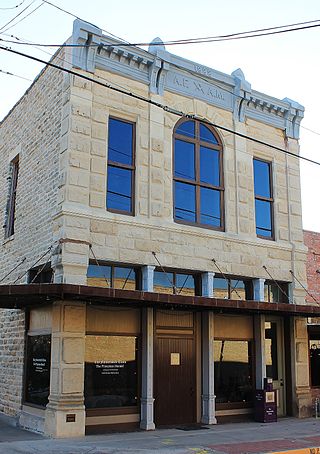
The Farmersville Masonic Lodge No. 214, A.F. and A.M. is a historic Italianate building located in Farmersville, Texas. It was constructed in 1888 as a meeting hall for Farmersville Lodge No. 214.

The Southside Masonic Lodge No. 1114 is a Masonic Lodge located in Fort Worth, Texas. The lodge was chartered on December 6, 1915, by the Grand Lodge of Texas, Ancient, Free & Accepted Masons. It was the fifth Masonic lodge in the city of Fort Worth chartered by the Grand Lodge of Texas, and its success in following decades was due to the growth of the south side of the city.

The Bank of Onslow and the Jacksonville Masonic Temple are two adjoining historic buildings located at 214 and 216 Old Bridge Street, in Jacksonville, Onslow County, North Carolina. The buildings are in the Beaux Arts architecture and Tudor Revival architecture, and were constructed in 1916, and 1919 respectively. They were jointly listed on the National Register of Historic Places in 1989 as a national historic district.
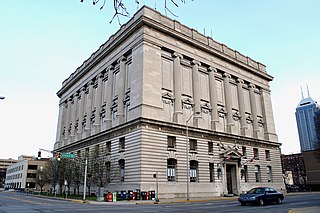
The current Indianapolis Masonic Temple, also known as Indiana Freemasons Hall, is a historic Masonic Temple located at Indianapolis, Indiana. Construction was begun in 1908, and the building was dedicated in May 1909. It is an eight-story, Classical Revival style cubic form building faced in Indiana limestone. The building features rows of engaged Ionic order columns. It was jointly financed by the Indianapolis Masonic Temple Association and the Grand Lodge of Free and Accepted Masons of Indiana, and was designed by the distinguished Indianapolis architectural firm of Rubush and Hunter.

The Brewster Building is a historic commercial building and IOOF Hall located at 201 Fourth Street in Galt, California. It was built in 1882 and was listed on the National Register of Historic Places in 2000.
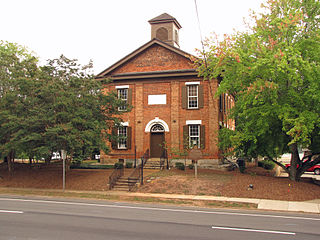
The Old Seminary Building, also known as Old Masonic Lodge or Lawrencevile Female Seminary Building, is a building in Lawrenceville, Georgia, USA, that was built in 1854 in Greek Revival and Federal style. It was originally constructed as a school but has had various tenants through the years, most notably Lawrenceville Lodge No. 131 Free and Accepted Masons, who used the second story of the building for meetings for more than a century.

Casselton Commercial Historic District is a 9.3-acre (3.8 ha) historic district in Casselton, North Dakota that was listed on the National Register of Historic Places in 1982.
The Kennett City Hall and Masonic Lodge, is a historic building located at Kennett, Dunklin County, Missouri, USA. It has also been known as the Dunklin County Museum. As originally constructed in 1903, the first floor was used exclusively as Kennett's City Hall and the second floor was occupied by several local Masonic organizations. The Masons moved to a new building in the 1950s, and in 1976 the city vacated the premises as well.
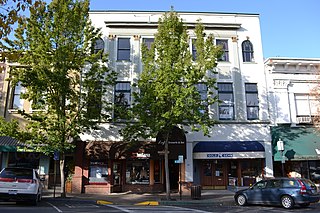
The Ashland Masonic Lodge Building is a historic building located in Ashland, Oregon. Constructed in 1909 as a meeting hall for a local Masonic lodge, it was listed on the National Register of Historic Places in 1992.
Grace Episcopal Church is a historic Episcopal church building is located at 210 C Avenue, South, in Minnewaukan, Benson County, North Dakota.

Elizabeth Hall is a historical building off Arkansas Highway 22 in New Blaine, Arkansas. It was built in 1867 as a Masonic meeting hall with funding and land donated by Masonic lodge members of Elizabeth Lodge 215 F & A M. The building is also known by that lodge's name. The lodge meets in the upper floor, while the ground floor has served as a school, a church, and a funeral chapel. The building has been described as "one of the finest remaining rural structures erected in nineteenth-century Arkansas". It was built "under the supervision of the New Blaine sheriff, E. N. Griffeth."

The Waterloo Masonic Temple is a historic building located in Waterloo, Iowa, United States. The first Masonic lodge in town, No. 105 A.F. & A.M, was established on the west side of the Cedar River in 1857. Lodge No. 296 was organized on the east side of the river in 1871, and the two consolidated into one lodge eight years later. They built their first Masonic Temple in 1899 at the intersection of Sycamore Street and East Park Avenue. The city was in the midst of a period economic growth that would see its population double each decade from 1890 to 1910. By 1918 the Masons felt the need for a new facility. Property at the intersection of East Park Avenue and Mulberry Street was acquired in 1920. Local architect John G. Ralston, a fellow Mason, was chosen to design the new building in what has been termed the "Phoenician Revival" style. The exterior walls were completed in 1925, but the interior wasn't completed until 1928. It is a four-story structure built over a raised basement. Its exterior walls are composed of dark red brick accented with light grey limestone. The main façade features a central entrance pavilion with three entrance ways that terminate in Moorish peaks near the roofline. Various Masonic symbols are found carved into the stone, and decorative brickwork flanks the central stone pavilion. The building was listed on the National Register of Historic Places in 2013.
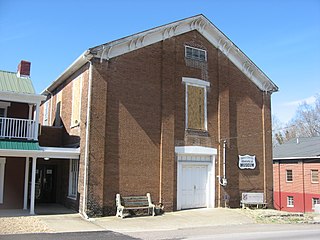
The Cadiz Masonic Lodge No. 121 F. and A.M., at Jefferson and Monroe Sts. in Cadiz, Kentucky, was built around 1854. It was listed on the National Register of Historic Places in 1979.

The Fayette County Courthouse Square Historic District in La Grange, Texas is a historic district roughly bounded by Main, Lafayette, Franklin, Colorado, Jefferson, Washington, and Crockett Streets. It was listed on the National Register of Historic Places on January 16, 2001. Two notable buildings in the district are the Fayette County Courthouse and Jail. Forty–seven buildings, three structures and four objects were identified as contributing to the historic nature of the district.


















